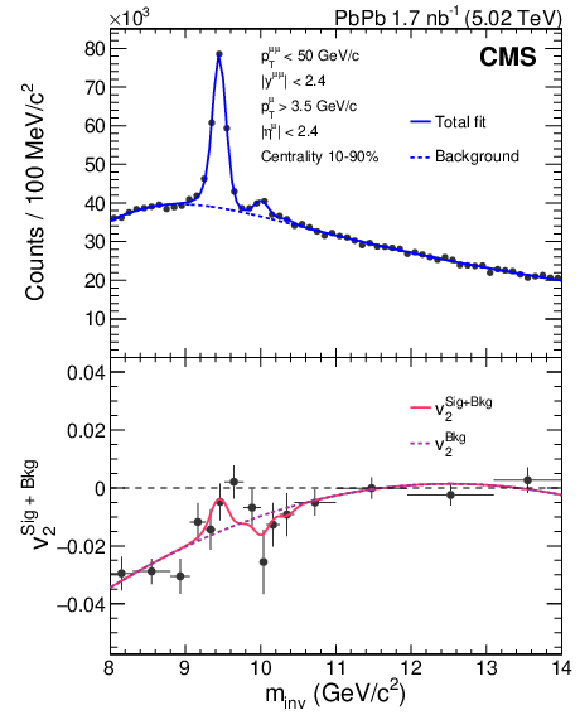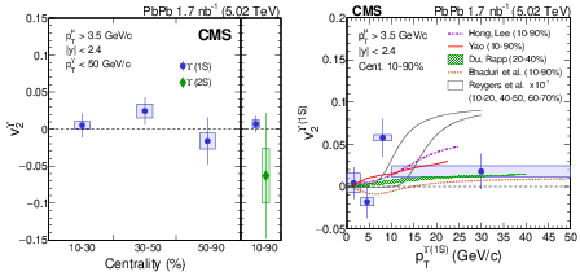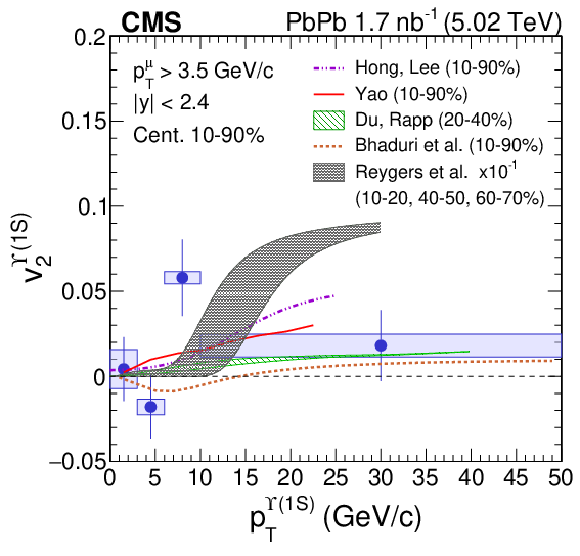

Compact Muon Solenoid
LHC, CERN
| CMS-HIN-19-002 ; CERN-EP-2020-039 | ||
| Measurement of the azimuthal anisotropy of $\Upsilon(\mathrm{1S})$ and $\Upsilon(\mathrm{2S})$ mesons in PbPb collisions at ${\sqrt {\smash [b]{s_{_{\mathrm {NN}}}}}} = $ 5.02 TeV | ||
| CMS Collaboration | ||
| 14 June 2020 | ||
| Phys. Lett. B 819 (2021) 136385 | ||
| Abstract: The second-order Fourier coefficients (${v_{2}} $) characterizing the azimuthal distribution of $\Upsilon(\mathrm{1S})$ and $\Upsilon(\mathrm{2S})$ mesons arising from PbPb collisions at ${\sqrt {\smash [b]{s_{_{\mathrm {NN}}}}}} =$ 5.02 TeV are studied. The $\Upsilon$ mesons are reconstructed in their dimuon decay channel, as measured by the CMS detector. The data set was collected in 2018 and corresponds to an integrated luminosity of 1.7 nb$^{-1}$. The scalar product method is used to extract the ${v_{2}} $ coefficients of the azimuthal distribution. Results are reported for the rapidity range $|y| < $ 2.4, with the transverse momentum 0 $ < {p_{\mathrm{T}}} < $ 50 GeV/$c$, and in three centrality ranges of 10-30, 30-50 and 50-90%. In contrast to the $\mathrm{J}/\psi$ mesons, no azimuthal anisotropy is observed for the $\Upsilon$ mesons. | ||
| Links: e-print arXiv:2006.07707 [hep-ex] (PDF) ; CDS record ; inSPIRE record ; HepData record ; CADI line (restricted) ; | ||
| Figures | |

png pdf |
Figure 1:
Simultaneous fit of the dimuon invariant mass spectrum and the $ {v_{2}} ^{\mathrm {Sig+Bkg}}$ distribution, as defined in Eq. (4), for $ {p_{\mathrm {T}}} < $ 50 GeV/$c$ and with centrality 10-90%. The solid (signal + background) and dashed (background only) blue lines show the result of the mass fit, and the solid and dashed red lines show the corresponding results for the binned $\chi ^2$ fit to the ${v_{2}}$ distribution. |

png pdf |
Figure 2:
(left) ${p_{\mathrm {T}}}$ integrated ${v_{2}}$ values for $\Upsilon(\mathrm{1S})$ mesons measured in four centrality bins and for the $\Upsilon(\mathrm{2S})$ meson in the 10-90% centrality range. (right) ${v_{2}}$ of $\Upsilon(\mathrm{1S})$ mesons as a function of ${p_{\mathrm {T}}}$ in the 10-90% centrality range compared with model calculations from Du and Rapp [22], Yao [42,43], Hong and Lee [44,45], and Bhaduri, Borghini, Jaiswal and Strickland [46]. All results are for the rapidity range of $ { | y |} < $ 2.4. The vertical bars denote statistical uncertainties, and the rectangular boxes show the total systematic uncertainties. |

png pdf |
Figure 2-a:
${p_{\mathrm {T}}}$ integrated ${v_{2}}$ values for $\Upsilon(\mathrm{1S})$ mesons measured in four centrality bins and for the $\Upsilon(\mathrm{2S})$ meson in the 10-90% centrality range. All results are for the rapidity range of $ { | y |} < $ 2.4. The vertical bars denote statistical uncertainties, and the rectangular boxes show the total systematic uncertainties. |

png pdf |
Figure 2-b:
${v_{2}}$ of $\Upsilon(\mathrm{1S})$ mesons as a function of ${p_{\mathrm {T}}}$ in the 10-90% centrality range compared with model calculations from Du and Rapp [22], Yao [42,43], Hong and Lee [44,45], and Bhaduri, Borghini, Jaiswal and Strickland [46]. All results are for the rapidity range of $ { | y |} < $ 2.4. The vertical bars denote statistical uncertainties, and the rectangular boxes show the total systematic uncertainties. |

png pdf |
Figure 3:
The ${v_{2}}$ coefficients for $\Upsilon(\mathrm{1S})$ mesons as a function of ${p_{\mathrm {T}}}$ in three centrality bins: 10-30% (left), 30-50% (middle) and 50-90% (right). The rapidity range is $ { | y |} < $ 2.4. The vertical lines indicate the statistical uncertainties and the rectangular boxes show the total systematic uncertainties. |

png pdf |
Figure 4:
The ${v_{2}}$ for $\Upsilon(\mathrm{1S})$ mesons as a function of ${p_{\mathrm {T}}}$ in the rapidity range $ { | y |} < $ 2.4 compared with the ALICE results for $\Upsilon(\mathrm{1S})$ (open circles) and $\mathrm{J}/\psi$ (full squares) mesons measured in 2.5 $ < y < $ 4 [24]. All results are measured in the range of 0 $ < {p_{\mathrm {T}}} < $ 15 GeV/$c$ and centrality interval 5-60%. The vertical bars denote statistical uncertainties, and the rectangular boxes show the total systematic uncertainties. |
| Summary |
| The ${v_{2}} $ coefficients for $\Upsilon(\mathrm{1S})$ and $\Upsilon(\mathrm{2S})$ mesons are measured in PbPb collisions at a nucleon-nucleon center-of-mass energy of 5.02 TeV. Results are reported for the rapidity range $|y| < $ 2.4, with transverse momentum 0 $ < {p_{\mathrm{T}}} < $ 50 GeV/$c$, and in three centrality intervals of 10-30, 30-50, and 50-90% for the $\Upsilon(\mathrm{1S})$ meson, while the centrality interval 10-90% is used for the $\Upsilon(\mathrm{2S})$ meson. The ${v_{2}} $ values are observed to be compatible with zero for the $\Upsilon(\mathrm{1S})$ meson in the measured kinematic bins and centrality intervals. This observation contrasts with the positive ${v_{2}} $ values reported for $\mathrm{J}/\psi$ mesons, suggesting different medium effects for charmonia and bottomonia. The measured values of ${v_{2}} $ are consistent with the predictions of several theoretical models. The ${v_{2}} $ value found for $\Upsilon(\mathrm{2S})$ mesons, which is being reported for the first time, is also consistent with zero. As there are expected to be differences in the various processes through which the QGP affects $\Upsilon(\mathrm{1S})$ and $\Upsilon(\mathrm{2S})$ mesons, these measurements provide new inputs for the study of bottomonia production in heavy ion collisions. |
| References | ||||
| 1 | W. Busza, K. Rajagopal, and W. van der Schee | Heavy ion collisions: the big picture and the big questions | Annual Review of Nuclear and Particle Science 68 (2018) 339 | 1802.04801 |
| 2 | F. Karsch, E. Laermann, and A. Peikert | The pressure in 2, 2+1 and 3 flavor QCD | PLB 478 (2000) 447 | hep-lat/0002003 |
| 3 | E. V. Shuryak | Theory of hadronic plasma | Sov. Phys. JETP 47 (1978) 212.[Zh. Eksp. Teor. Fiz., 74 (1978) 408] | |
| 4 | T. Matsui and H. Satz | $ \mathrm{J}/\psi $ suppression by quark-gluon plasma formation | PLB 178 (1986) 416 | |
| 5 | CMS Collaboration | Observation of sequential Upsilon suppression in PbPb collisions | PRL 109 (2012) 222301 | CMS-HIN-11-011 1208.2826 |
| 6 | CMS Collaboration | Suppression of $ {\sqrt {\smash [b]{s_{_{\mathrm {NN}}}}}} $, $ $\Upsilon(\text{2S})$ $, and $ $\Upsilon(\text{3S})$ $ quarkonium states in PbPb collisions at $ {\sqrt {\smash [b]{s_{_{\mathrm {NN}}}}}} = $ 2.76 TeV | PLB 770 (2017) 357 | CMS-HIN-15-001 1611.01510 |
| 7 | ALICE Collaboration | $ \Upsilon $ suppression at forward rapidity in Pb-Pb collisions at $ {\sqrt {\smash [b]{s_{_{\mathrm {NN}}}}}} = $ 5.02 TeV | PLB 790 (2019) 89 | 1805.04387 |
| 8 | CMS Collaboration | Suppression of excited $ \Upsilon $ states relative to the ground state in Pb-Pb collisions at $ {\sqrt {\smash [b]{s_{_{\mathrm {NN}}}}}} = $ 5.02 TeV | PRL 120 (2018) 142301 | CMS-HIN-16-008 1706.05984 |
| 9 | CMS Collaboration | Measurement of nuclear modification factors of $ {\sqrt {\smash [b]{s_{_{\mathrm {NN}}}}}} $, $ $\Upsilon(\text{2S})$ $, and $ $\Upsilon(\text{3S})$ $ mesons in PbPb collisions at $ {\sqrt {\smash [b]{s_{_{\mathrm {NN}}}}}} = $ 5.02 TeV | PLB 790 (2019) 270 | CMS-HIN-16-023 1805.09215 |
| 10 | STAR Collaboration | Suppression of $ \Upsilon $ production in d+Au and Au+Au collisions at $ {\sqrt {\smash [b]{s_{_{\mathrm {NN}}}}}} = $ 200 GeV | PLB 735 (2014) 127 | 1312.3675 |
| 11 | A. Andronic et al. | Heavy-flavour and quarkonium production in the LHC era: from proton--proton to heavy-ion collisions | EPJC 76 (2016) 107 | 1506.03981 |
| 12 | L. He et al. | Anisotropic parton escape is the dominant source of azimuthal anisotropy in transport models | PLB 753 (2016) 506 | 1502.05572 |
| 13 | N. Borghini and C. Gombeaud | Anisotropic flow far from equilibrium | EPJC 71 (2011) 1612 | 1012.0899 |
| 14 | P. Romatschke | Collective flow without hydrodynamics: simulation results for relativistic ion collisions | EPJC 75 (2015) 429 | 1504.02529 |
| 15 | A. Jaiswal and P. P. Bhaduri | Effect of an anisotropic escape mechanism on elliptic flow in relativistic heavy-ion collisions | PRC 97 (2018) 044909 | 1712.02707 |
| 16 | S. Voloshin and Y. Zhang | Flow study in relativistic nuclear collisions by fourier expansion of azimuthal particle distributions | Z. Phys. C 70 (1996) 665 | hep-ph/9407282 |
| 17 | ALICE Collaboration | Search for collectivity with azimuthal $ \mathrm{J}/\psi $-hadron correlations in high multiplicity p-Pb collisions at $ {\sqrt {\smash [b]{s_{_{\mathrm {NN}}}}}} = $ 5.02 and 8.16 TeV | PLB 780 (2018) 7 | 1709.06807 |
| 18 | ALICE Collaboration | $ \mathrm{J}/\psi $ elliptic flow in Pb-Pb collisions at $ {\sqrt {\smash [b]{s_{_{\mathrm {NN}}}}}} = $ 5.02 TeV | PRL 119 (2017) 242301 | 1709.05260 |
| 19 | CMS Collaboration | Suppression and azimuthal anisotropy of prompt and nonprompt $ \mathrm{J}/\psi $ production in PbPb collisions at $ {\sqrt {\smash [b]{s_{_{\mathrm {NN}}}}}} = $ 2.76 TeV | EPJC 77 (2017) 252 | CMS-HIN-14-005 1610.00613 |
| 20 | B. Krouppa and M. Strickland | Predictions for bottomonia suppression in 5.023 TeV Pb--Pb collisions | Universe 2 (2016) 16 | 1605.03561 |
| 21 | N. Brambilla, M. A. Escobedo, J. Soto, and A. Vairo | Quarkonium suppression in heavy-ion collisions: an open quantum system approach | PRD 96 (2017) 034021 | 1612.07248 |
| 22 | X. Du, R. Rapp, and M. He | Color screening and regeneration of bottomonia in high-energy heavy-ion collisions | PRC 96 (2017) 054901 | 1706.08670 |
| 23 | A. Emerick, X. Zhao, and R. Rapp | Bottomonia in the quark-gluon plasma and their production at RHIC and LHC | EPJA 48 (2012) 72 | 1111.6537 |
| 24 | ALICE Collaboration | Measurement of $ {\sqrt {\smash [b]{s_{_{\mathrm {NN}}}}}} $ elliptic flow at forward rapidity in Pb-Pb collisions at $ {\sqrt {\smash [b]{s_{_{\mathrm {NN}}}}}} = $ 5.02 TeV | PRL 123 (2019) 192301 | 1907.03169 |
| 25 | M. Luzum and J.-Y. Ollitrault | Eliminating experimental bias in anisotropic-flow measurements of high-energy nuclear collisions | PRC 87 (2013) 044907 | 1209.2323 |
| 26 | CMS Collaboration | The CMS experiment at the CERN LHC | JINST 3 (2008) S08004 | CMS-00-001 |
| 27 | CMS Collaboration | The CMS trigger system | JINST 12 (2017) P01020 | CMS-TRG-12-001 1609.02366 |
| 28 | CMS Collaboration | Description and performance of track and primary-vertex reconstruction with the CMS tracker | JINST 9 (2014) P10009 | CMS-TRK-11-001 1405.6569 |
| 29 | CMS Collaboration | Transverse momentum and pseudorapidity distributions of charged hadrons in pp collisions at $ \sqrt{s} = $ 0.9 and 2.36 TeV | JHEP 02 (2010) 041 | CMS-QCD-09-010 1002.0621 |
| 30 | T. Sjostrand et al. | An introduction to PYTHIA 8.2 | CPC 191 (2015) 159 | 1410.3012 |
| 31 | CMS Collaboration | Extraction and validation of a new set of CMS PYTHIA8 tunes from underlying-event measurements | EPJC 80 (2020) 4 | CMS-GEN-17-001 1903.12179 |
| 32 | R. Baier and R. Ruckl | Hadronic collisions: a quarkonium factory | Z. Phys. C 19 (1983) 251 | |
| 33 | R. Gastmans, W. Troost, and T. T. Wu | Cross-sections for gluon + gluon $ \rightarrow $ heavy quarkonium + gluon | PLB 184 (1987) 257 | |
| 34 | P. L. Cho and A. K. Leibovich | Color-octet quarkonia production. II. | PRD 53 (1996) 6203 | hep-ph/9511315 |
| 35 | GEANT4 Collaboration | GEANT4--a simulation toolkit | NIMA 506 (2003) 250 | |
| 36 | I. P. Lokhtin et al. | Heavy ion event generator HYDJET++ (hydrodynamics plus jets) | CPC 180 (2009) 779 | 0809.2708 |
| 37 | CMS Collaboration | Measurements of inclusive W and Z cross sections in pp collisions at $ \sqrt{s} = $ 7 TeV | JHEP 01 (2011) 080 | CMS-EWK-10-002 1012.2466 |
| 38 | CMS Collaboration | Performance of CMS muon reconstruction in pp collision events at $ \sqrt{s}= $ 7 TeV | JINST 7 (2012) P10002 | CMS-MUO-10-004 1206.4071 |
| 39 | CMS Collaboration | Measurement of prompt $ D^0 $ meson azimuthal anisotropy in Pb-Pb collisions at $ {\sqrt {\smash [b]{s_{_{\mathrm {NN}}}}}} = $ 5.02 TeV | PRL 120 (2018) 202301 | CMS-HIN-16-007 1708.03497 |
| 40 | M. J. Oreglia | A study of the reactions $\psi' \to \gamma\gamma \psi$ | PhD thesis, Stanford University, 1980 SLAC Report SLAC-R-236, see A | |
| 41 | Particle Data Group, M. Tanabashi et al. | Review of particle physics | PRD 98 (2018) 030001 | |
| 42 | X. Yao et al. | Coupled Boltzmann transport equations of heavy quarks and quarkonia in quark-gluon plasma | 2004.06746 | |
| 43 | X. Yao and B. Muller | Quarkonium inside the quark-gluon plasma: diffusion, dissociation, recombination, and energy loss | PRD 100 (2019) 014008 | 1811.09644 |
| 44 | J. Hong and S. H. Lee | $ {\sqrt {\smash [b]{s_{_{\mathrm {NN}}}}}} $ transverse momentum spectra through dissociation and regeneration in heavy ion collisions | PLB 801 (2020) 135147 | 1909.07696 |
| 45 | W. Ke, Y. Xu, and S. A. Bass | Linearized Boltzmann-Langevin model for heavy quark transport in hot and dense QCD matter | PRC 98 (2018) 064901 | 1806.08848 |
| 46 | P. P. Bhaduri, N. Borghini, A. Jaiswal, and M. Strickland | Anisotropic escape mechanism and elliptic flow of bottomonia | PRC 100 (2019) 051901 | 1809.06235 |

|
Compact Muon Solenoid LHC, CERN |

|

|

|

|

|

|